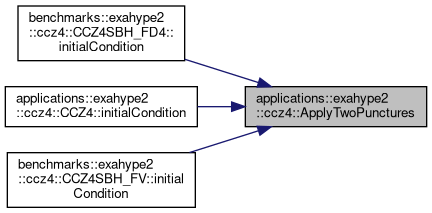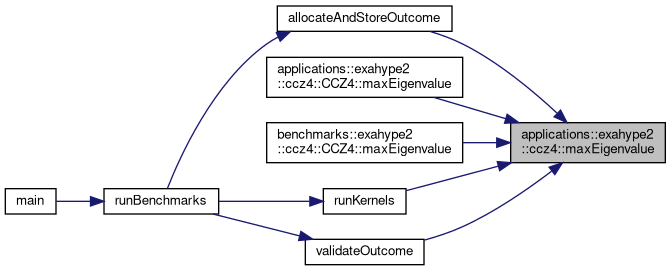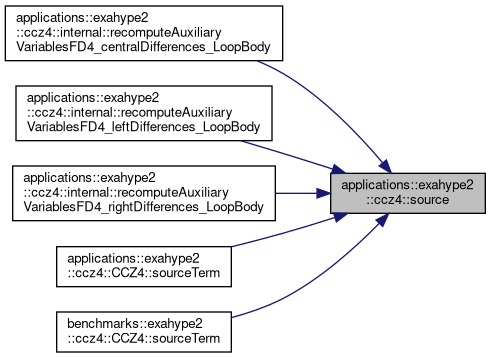|
Peano
|
|
Peano
|
Namespaces | |
| namespace | internal |
Data Structures | |
| class | CCZ4 |
Functions | |
| static void | ncp (double *BgradQ, const double *const Q, const double *const gradQSerialised, const int normal, const int CCZ4LapseType, const double CCZ4ds, const double CCZ4c, const double CCZ4e, const double CCZ4f, const double CCZ4bs, const double CCZ4sk, const double CCZ4xi, const double CCZ4mu, const double CCZ4SO) |
| static void | source (double *S, const double *const Q, const int CCZ4LapseType, const double CCZ4ds, const double CCZ4c, const double CCZ4e, const double CCZ4f, const double CCZ4bs, const double CCZ4sk, const double CCZ4xi, const double CCZ4itau, const double CCZ4eta, const double CCZ4k1, const double CCZ4k2, const double CCZ4k3, const double CCZ4SO) |
| The source term is one out of two terms that we use in our CCZ4 formulation. | |
| static double | maxEigenvalue (const double *const Q, int normal, const double CCZ4e, const double CCZ4ds, const double CCZ4GLMc, const double CCZ4GLMd) |
| void | admconstraints (double *constraints, const double *const Q, const double *const gradQSerialised) |
| This is a postprocessing routine to monitor if the physical constraints are fulfilled. | |
| void | ThetaOutputNCP (double *NCPterm, const double *const Q, const double *const gradQSerialised, int normal) |
| A temporary test function, to output Hamilton constraint related term in theta, 1 terms: RPlusTwoNablaZNCP. | |
| void | TestingOutput (double *terms, const double *const Q, const double *const gradQSerialised) |
| A temporary test function, to output some testing values 0,1 entries: Hamilton constraint related term in theta, 2 terms: RPlusTwoNablaZSrc, pure Src 2-10 entry: no-symmetry version of R_ij. | |
| void | Psi4Calc (double *Psi4, const double *const Q, const double *const gradQSerialised, double *coor) |
| This function is for the calculation of psi4, a quantity related to gravitional wave. | |
| void | enforceCCZ4constraints (double *NOALIAS newQ) |
| A postprocessing routine which pushes the volume solution back into the area of the CCZ4 constraints. | |
| void | enforceCCZ4constraints (const double *NOALIAS oldQ, double *NOALIAS dQdt, double timeStepSize) |
| Anticipate Euler step and correct dQdt such that outcome does fulfill constraints. | |
| static void | ncp (double *BgradQ, const double *const Q, const double *const gradQSerialised, const int normal, const int CCZ4LapseType, const double CCZ4ds, const double CCZ4c, const double CCZ4e, const double CCZ4f, const double CCZ4bs, const double CCZ4sk, const double CCZ4xi, const double CCZ4mu, const double CCZ4SO) |
| static void | source (double *S, const double *const Q, const int CCZ4LapseType, const double CCZ4ds, const double CCZ4c, const double CCZ4e, const double CCZ4f, const double CCZ4bs, const double CCZ4sk, const double CCZ4xi, const double CCZ4itau, const double CCZ4eta, const double CCZ4k1, const double CCZ4k2, const double CCZ4k3, const double CCZ4SO) |
| The source term is one out of two terms that we use in our CCZ4 formulation. | |
| static double | maxEigenvalue (const double *const Q, int normal, const double CCZ4e, const double CCZ4ds, const double CCZ4GLMc, const double CCZ4GLMd) |
| void | gaugeWave (double *NOALIAS Q, const tarch::la::Vector< DIMENSIONS, double > &x, double t) |
| void | diagonal_gaugeWave (double *NOALIAS Q, const tarch::la::Vector< DIMENSIONS, double > &x, double t) |
| void | linearWave (double *NOALIAS Q, const tarch::la::Vector< DIMENSIONS, double > &X, double t) |
| void | flat (double *NOALIAS Q, const tarch::la::Vector< DIMENSIONS, double > &X, double t) |
| void | ApplyTwoPunctures (double *NOALIAS Q, const tarch::la::Vector< DIMENSIONS, double > &X, double t, TP::TwoPunctures *tp, bool low_res) |
| void | recomputeAuxiliaryVariablesFD4_4thOrder (::exahype2::CellData< double, double > &patchData, int numberOfGridCellsPerPatchPerAxis, int haloSize, int unknowns, int auxiliaryVariables) |
| Recompute auxiliary variables for FD4 scheme with a 4th order scheme. | |
| void | recomputeAuxiliaryVariablesFD4_centralDifferences (::exahype2::CellData< double, double > &patchData, int numberOfGridCellsPerPatchPerAxis, int haloSize, int unknowns, int auxiliaryVariables) |
| void | recomputeAuxiliaryVariablesFD4_leftDifferences (::exahype2::CellData< double, double > &patchData, int numberOfGridCellsPerPatchPerAxis, int haloSize, int unknowns, int auxiliaryVariables) |
| void | recomputeAuxiliaryVariablesFD4_rightDifferences (::exahype2::CellData< double, double > &patchData, int numberOfGridCellsPerPatchPerAxis, int haloSize, int unknowns, int auxiliaryVariables) |
| void applications::exahype2::ccz4::admconstraints | ( | double * | constraints, |
| const double *const | Q, | ||
| const double *const | gradQSerialised ) |
This is a postprocessing routine to monitor if the physical constraints are fulfilled.
Used in python script.
Definition at line 123 of file CCZ4Kernels.cpp.
| void applications::exahype2::ccz4::ApplyTwoPunctures | ( | double *NOALIAS | Q, |
| const tarch::la::Vector< DIMENSIONS, double > & | X, | ||
| double | t, | ||
| TP::TwoPunctures * | tp, | ||
| bool | low_res ) |
Definition at line 133 of file InitialValues.cpp.
References TP_bindding::AuxiliaryCal(), TP_bindding::GradientCal(), TP::TwoPunctures::Interpolate(), and TP_bindding::SOCCZ4Cal().
Referenced by applications::exahype2::ccz4::CCZ4::initialCondition(), benchmarks::exahype2::ccz4::CCZ4SBH_FD4::initialCondition(), and benchmarks::exahype2::ccz4::CCZ4SBH_FV::initialCondition().


| void applications::exahype2::ccz4::diagonal_gaugeWave | ( | double *NOALIAS | Q, |
| const tarch::la::Vector< DIMENSIONS, double > & | x, | ||
| double | t ) |
< Amplitude of the wave, B in the note
Definition at line 54 of file InitialValues.cpp.
Referenced by applications::exahype2::ccz4::CCZ4::initialCondition().

| void applications::exahype2::ccz4::enforceCCZ4constraints | ( | const double *NOALIAS | oldQ, |
| double *NOALIAS | dQdt, | ||
| double | timeStepSize ) |
Anticipate Euler step and correct dQdt such that outcome does fulfill constraints.
Definition at line 13 of file CCZ4Kernels.cpp.
References enforceCCZ4constraints(), and timeStepSize.

| void applications::exahype2::ccz4::enforceCCZ4constraints | ( | double *NOALIAS | newQ | ) |
A postprocessing routine which pushes the volume solution back into the area of the CCZ4 constraints.
This is a local operation that we can invoke after each time step per volume.
If works on the full set of unknowns of the first-order formulation
References timeStepSize.
Referenced by enforceCCZ4constraints().

| void applications::exahype2::ccz4::flat | ( | double *NOALIAS | Q, |
| const tarch::la::Vector< DIMENSIONS, double > & | X, | ||
| double | t ) |
Definition at line 119 of file InitialValues.cpp.
Referenced by applications::exahype2::ccz4::CCZ4::initialCondition().

| void applications::exahype2::ccz4::gaugeWave | ( | double *NOALIAS | Q, |
| const tarch::la::Vector< DIMENSIONS, double > & | x, | ||
| double | t ) |
< Amplitude of the wave
Definition at line 21 of file InitialValues.cpp.
Referenced by applications::exahype2::ccz4::CCZ4::initialCondition().

| void applications::exahype2::ccz4::linearWave | ( | double *NOALIAS | Q, |
| const tarch::la::Vector< DIMENSIONS, double > & | X, | ||
| double | t ) |
< Amplitude of the wave, should be very small to keep linearized.
Definition at line 93 of file InitialValues.cpp.
Referenced by applications::exahype2::ccz4::CCZ4::initialCondition().

|
static |
References timeStepSize.
|
static |
Referenced by applications::exahype2::ccz4::CCZ4::maxEigenvalue().

|
static |
|
static |
| void applications::exahype2::ccz4::Psi4Calc | ( | double * | Psi4, |
| const double *const | Q, | ||
| const double *const | gradQSerialised, | ||
| double * | coor ) |
This function is for the calculation of psi4, a quantity related to gravitional wave.
Not used yet.
Definition at line 361 of file CCZ4Kernels.cpp.
| void applications::exahype2::ccz4::recomputeAuxiliaryVariablesFD4_4thOrder | ( | ::exahype2::CellData< double, double > & | patchData, |
| int | numberOfGridCellsPerPatchPerAxis, | ||
| int | haloSize, | ||
| int | unknowns, | ||
| int | auxiliaryVariables ) |
Recompute auxiliary variables for FD4 scheme with a 4th order scheme.
We are given a patch as well as the number of mesh cells per axis within this patch. I also parameterise over the unknowns and the auxiliaryVariables. By default, we'd expect 59 and 0 here, but we want to routine to work for augmented systems, too.
The reconstruction uses a 4th order Finite Difference scheme. The implementation in applications::exahype2::ccz4::internal::recomputeAuxiliaryVariablesFD4_4thOrder_LoopBody() realises the normal stencil
scaled with \( \frac{1}{12h} \). There is a fundamental problem with this variant which is worth mentioning: To evaluate this stencil, we need a halo layer of at least two. For a given haloSize, we can never update the outermost two layers of the code.

As we use a fourth order scheme, we need two neighbours around each point to construct the outcome. That means, when we are given a patch with size 3 (left illustation above), we effectively can only calculate the auxiliary variables within the patch (green) and the first halo layer around it (brownish). This is illustrated to the right.
There's one further complexity: we usually do not have the digonal values in ExaHyPE. What we really get is not the illustration above to the left but the one in the centre. The diagonal blocks hold garbage. As a consequence, the auxiliary data in the brown data layer to the right is not properly computed. In the left brown layer, only the x-derivatives are properly reconstructed. The y-derivatives contain garbage.
| patchData | Host the actual patch data. For this function, we only have to ensure that the QIn (data plus halo) are properly set, and that the patch size in patchData is correct. All the other (meta data) properties have no influence and can hold any data. |
| numberOfGridCellsPerPatchPerAxis | Has to be at least 3, as the halo is also at least three. More general, has to be bigger or equal to haloSize. |
| haloSize | Has to be at least 3. |
| unknowns | Typically 59, but can be bigger if you hold additional quantities within the PDE. |
| auxiliaryVariables | Typically 0. |
Definition at line 155 of file SecondOrderAuxiliaryVariablesReconstruction.cpp.
References applications::exahype2::ccz4::internal::recomputeAuxiliaryVariablesFD4_4thOrder_LoopBody().

| void applications::exahype2::ccz4::recomputeAuxiliaryVariablesFD4_centralDifferences | ( | ::exahype2::CellData< double, double > & | patchData, |
| int | numberOfGridCellsPerPatchPerAxis, | ||
| int | haloSize, | ||
| int | unknowns, | ||
| int | auxiliaryVariables ) |
Definition at line 104 of file SecondOrderAuxiliaryVariablesReconstruction.cpp.
| void applications::exahype2::ccz4::recomputeAuxiliaryVariablesFD4_leftDifferences | ( | ::exahype2::CellData< double, double > & | patchData, |
| int | numberOfGridCellsPerPatchPerAxis, | ||
| int | haloSize, | ||
| int | unknowns, | ||
| int | auxiliaryVariables ) |
Definition at line 121 of file SecondOrderAuxiliaryVariablesReconstruction.cpp.
| void applications::exahype2::ccz4::recomputeAuxiliaryVariablesFD4_rightDifferences | ( | ::exahype2::CellData< double, double > & | patchData, |
| int | numberOfGridCellsPerPatchPerAxis, | ||
| int | haloSize, | ||
| int | unknowns, | ||
| int | auxiliaryVariables ) |
Definition at line 138 of file SecondOrderAuxiliaryVariablesReconstruction.cpp.
|
static |
The source term is one out of two terms that we use in our CCZ4 formulation.
As it is used within the compute kernel, we also want to use it on the GPU, and we want to vectorise over it aggressively. To make this work, we have to inline the function plus ensure that the interna of the function are not vectorised before we inline the routine.
So we first declare it as simd and then we also say explicitly that it should be inlined. In my opinion, the inlining should imply that we wanna use it as SIMD, but my guess is that the simd statement ensures that the compiler doesn't prematurely vectorise.
|
static |
The source term is one out of two terms that we use in our CCZ4 formulation.
As it is used within the compute kernel, we also want to use it on the GPU, and we want to vectorise over it aggressively. To make this work, we have to inline the function plus ensure that the interna of the function are not vectorised before we inline the routine.
So we first declare it as simd and then we also say explicitly that it should be inlined. In my opinion, the inlining should imply that we wanna use it as SIMD, but my guess is that the simd statement ensures that the compiler doesn't prematurely vectorise.
Referenced by applications::exahype2::ccz4::internal::recomputeAuxiliaryVariablesFD4_centralDifferences_LoopBody(), applications::exahype2::ccz4::internal::recomputeAuxiliaryVariablesFD4_leftDifferences_LoopBody(), applications::exahype2::ccz4::internal::recomputeAuxiliaryVariablesFD4_rightDifferences_LoopBody(), applications::exahype2::ccz4::CCZ4::sourceTerm(), and benchmarks::exahype2::ccz4::CCZ4::sourceTerm().

| void applications::exahype2::ccz4::TestingOutput | ( | double * | terms, |
| const double *const | Q, | ||
| const double *const | gradQSerialised ) |
A temporary test function, to output some testing values 0,1 entries: Hamilton constraint related term in theta, 2 terms: RPlusTwoNablaZSrc, pure Src 2-10 entry: no-symmetry version of R_ij.
Definition at line 657 of file CCZ4Kernels.cpp.
| void applications::exahype2::ccz4::ThetaOutputNCP | ( | double * | NCPterm, |
| const double *const | Q, | ||
| const double *const | gradQSerialised, | ||
| int | normal ) |
A temporary test function, to output Hamilton constraint related term in theta, 1 terms: RPlusTwoNablaZNCP.
Definition at line 928 of file CCZ4Kernels.cpp.